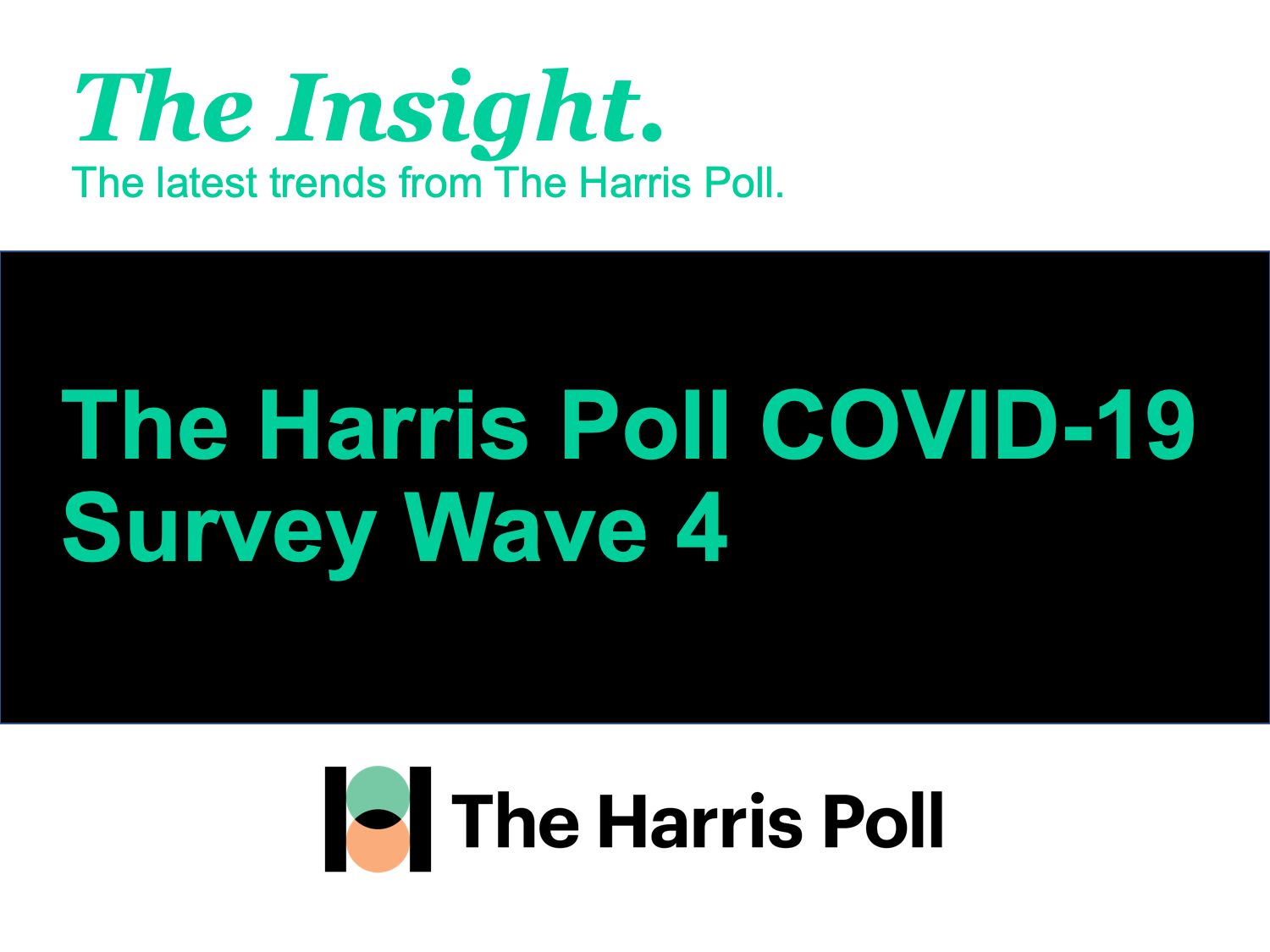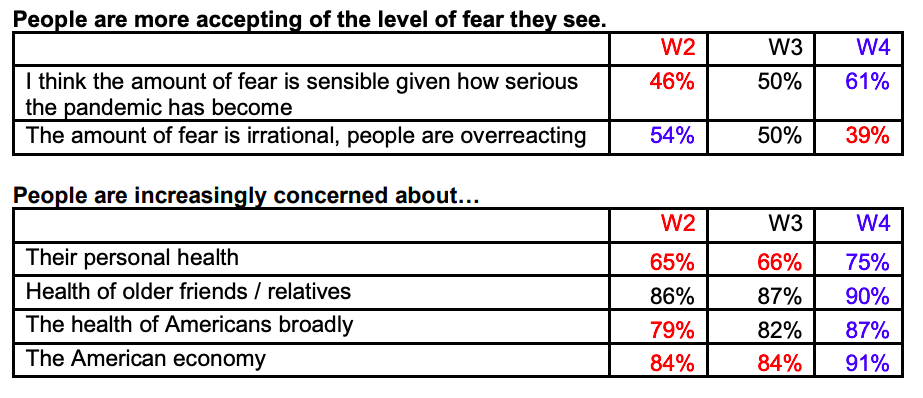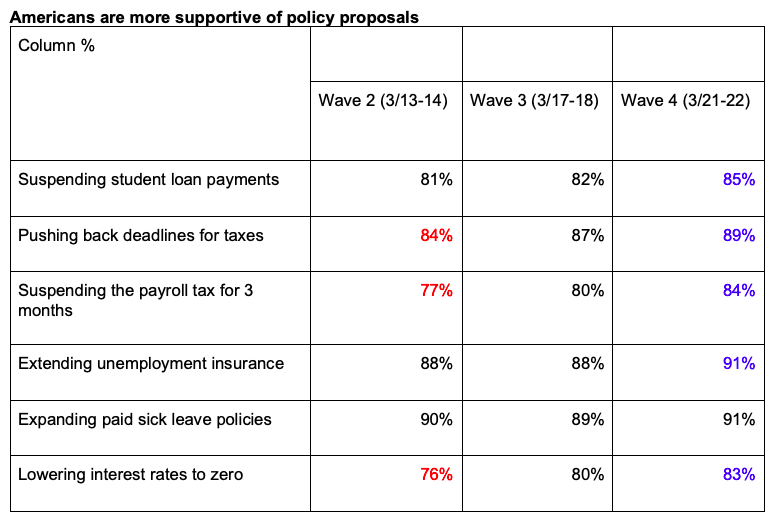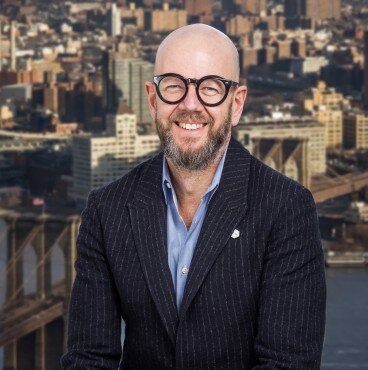Brief • 4 min Read

National Fear Is Rising Across the Board
Americans are more accepting of national fear, less think the public is overreacting
- More people think they’re going to get COVID-19 (20% up from 16% to start)
- A huge 35% say they fear they could die from COVID

American Concern of Healthcare Shortages is Rising
Americans are increasingly concerned about healthcare shortages to address COVID19 outbreak
- Nearly 9 in 10 Americans are concerned of a potential shortage of healthcare workers (doctors, nurses, support staff (Up 8% since last week)
- 86% of Americans are concerned about a potential shortage of hospital ventilators (for assisted breathing) or hospital beds (up 9% for each in the last week)
- Around 4 in 5 Americans are concerned about a potential shortage of surgical masks and gloves (83%), or testing kits for COVID-19 (82%).
- Concern for a shortage of surgical masks and gloves and testing kits for COVID19 have increased since last week (12% increase and 9% increase, respectively).
Technology is Helping Society Cope with Social Distancing
While a quarter of Americans feel isolated, over a third of Americans are staying connected virtually with family and friends with Gen Z is leading the way…
- 55% of Gen Z and Nearly 4 in 10 Americans say they are virtually connecting with family and friends via FaceTime and other means to cope with social distancing
- Higher among women (43%) than men (34%)
- Over one third (35%) of Gen Z had a virtual gathering with friends just in the last week (20% of all Americans)
- Overall, 33% of Americans have a more positive opinion of technology companies right now
Searching for reprieve amid the pandemic by tuning out the news; 4 in 10 Americans say they are ‘Reading more non-news related content to cope with social distancing
- Creating a structure, over 3 in 10 Gen Z are setting routine breaks in the workday vs only 10% of adults ages 55-64 and 15% 45-54
Staying active, mentally and physically; over half of Gen Z are getting back into old hobbies and over a third are going for daily walks
- 36% are getting back into old hobbies and a quarter (25%) are picking up new ones
- This is highest among Gen Z (54%) and lowest among older Americans 65+ (27%)
- 36% are going for daily walks, this is highest among older Americans 65+ (40%)
Leaning on community during hard times…
- 44% say they have Checked in With Someone I hadn’t Reached Out to in a while
- Highest among women (49%) vs men (38%)
- Nearly a fifth (19%) have ‘Helped an at-risk friend or neighbor with errands
Will Americans Obey Lockdowns & What Will They Go Out For
Nearly 1 in 5 Americans will be ordered to stay in-doors by Monday morning – will they obey for the greater good?
If ordered to stay indoors, most Americans would comply with non-essential activity (gym, dinners, school) but most will still go to the grocery store
- Most Americans would refrain from going to the gym (91%), hosting dinner (89%), or going to school (88%);
- But most Americans would still leave the house to go to the grocery store (85%), the pharmacy (81%), or to care for family members in another household (67%).
Gen Z are least compliant; a third would visit friends and half would go to restaurants for take-out
- It won’t take much, though, for Gen Z to go outside, even if under lock down. A third (32%) of those aged 18-24 would go out to visit friends, over half would go to a restaurant for carry-out (53%), 28% would have dinner at a friend’s house.
Overall, Americans plan on complying with the sweeping national restrictions
- The vast majority of Americans would follow mandates that restrict: convening groups larger than 10 people (93%), international travel (94%), non-essential workers to their homes (91%).
Americans expect the social distancing guidelines to last ten and a half weeks.
Food Delivery vs Grocery Delivery
Over 6 in 10 Americans are more likely to order take out and pick up themselves over using food delivery apps, but younger generations are still leaning more on the apps…
- 62% of Americans are more likely to ‘Order take out from a restaurant and pick it up themselves’ vs Ordering food delivery from an app (38%)
- Younger Americans are more likely to do both while older generations are much more likely to order takeout from a restaurant
- Order take out from a restaurant:
- 78% (55-64) and 82% of (65+)
- 48% of Gen Z (18-24) and Millennials (25-34) and adults ages 35-44
- Order food delivery from an app:
- 52% of Gen Z (18-24) and Millennials (25-34) and adults ages 35-44
- 22% of 55-64 and 18% of 65+
- Order take out from a restaurant:
Three quarters of Americans are more likely to buy groceries in person during the pandemic vs home delivered groceries, especially older Americans who are more vulnerable….
- Overall majority (73%) say they would buy groceries in person vs order home delivery groceries (27%)
- Older Americans are the least likely to order home delivery groceries; less than a fifth (17%) of adults over 55 say they would do this vs over 3 in 10 Gen Z (33%) and Millennials (36%) and 35-44 (37%)
How Long Until Americans Return to Normal Activity Once the Virus Flattens?
Americans are eager to get back into the office immediately after restrictions are lifted
- Over 1 in 5 Americans (22%) say that once the government provides information that the spread of the virus is flattening, they would be willing to immediately go to the office
It may be a month after restrictions are lifted for Americans to go back to dining out and going to the gym
- Nearly a third (28%) of Americans say that only after 1-30 days they would go out to dinner, following the news that the virus is flattening. After just 1-30 days Americans say they would also go to a gym class (17%).
It could take 2-3 months for Americans to attend large social gatherings, movies, and take public transportation
- After just 2-3 months, nearly a fifth of Americans say they would host/attend a larger social gathering (22%), go to the movies (21%), greet people with a handshake (21%), stay in a hotel (20%), or go to a sporting event (17%).
- 15% of Americans say it will take 2-3 months for them to be able to visit a casino or take public transportation (e.g., subway, busses, trains) again.
Airlines and Cruises may be impacted the worst; nearly a fifth say it would take them 4-6 months to fly again
- (18%) say it would take them 4-6 months following the news of the virus flattening for them to fly in a plane again.
- Americans are keeping their distance from cruise ships for the time being, with 22% of Americans who say it will take a year or longer before they take a cruise and 1 in 10 say never again
While Employers Are Starting to Take More Action, Many American Workers Are at Risk
While employers are starting take more action to support employees, the Coronavirus continues to hurt the American workforce, 20% have been laid off or put on temporary leave
- The number of Americans who said they employer has taken no action has dropped from 35% to 23% in just a week
- 19% say their employer has offered paid sick leave (up from 14% in wave 1) and 14% have offered OOP healthcare costs (up from 12% in wave 1)
- But, 20% of all Americans say they’ve been laid off or put on temp leave
- Highest among lower HHI adults – 23% of those HHI <$50k and only 17% of those with HHI $100k+
- 86% say this will result in a global recession.
Inequality Across Online learning
- Only 8% of adults with a HHI less than $50k say they have Participated in a virtual “homeschool” class (art, math, science, etc.-geared to children) vs 18% of those with a HHI of $100k+
Government and Political Responses
- Americans are increasingly dissatisfied with the federal government response in providing economic relief to taxpayers 62% say it has not been enough vs 38% who say it has been sufficient
- Americans are split on Trump’s characterization of Coronavirus as “The China Virus” (48% disagree / 52% agree) and most (55%) of Americans say the Chinese government is to blame for coronavirus spreading to the US.
- People are moderately satisfied with the white house response (62%), but more satisfied with the local (76%) and state (76%)
- This crisis hasn’t seemed to make a difference in support for universal healthcare.
- People are getting information from virtually everywhere. They trust the white house moderately (62%) – but local and state leaders are trusted more (81% and 82% respectively).
- This crisis hasn’t seemed to make a difference in support for universal healthcare.


METHODOLOGY
This survey (wave 4) was fielded online among a nationally representative sample of 2,023 U.S adults from March 21-22, 2020.
Wave 3 of the survey was fielded online among a nationally representative sample of 2,019 U.S adults from March 17-18, 2020.
Wave 2 of the survey was fielded online among a nationally representative sample of 2,050 U.S adults from March 14-15, 2020.
ABOUT THE HARRIS POLL
The Harris Poll is one of the longest running surveys in the U.S. tracking public opinion, motivations and social sentiment since 1963 that is now part of Harris Insights & Analytics, a global consulting and market research firm that delivers social intelligence for transformational times. We work with clients in three primary areas; building twenty-first-century corporate reputation, crafting brand strategy and performance tracking, and earning organic media through public relations research. Our mission is to provide insights and advisory to help leaders make the best decisions possible. Learn more at our website and follow us on Twitter and LinkedIn. For specific questions and media inquiries please contact Tawny Saez.
Subscribe for more Insights
Subscribe to our newsletter for the latest trends in business, politics, culture, and more.
Download the Data
This survey was fielded online among a nationally representative sample of 2,023 U.S adults from March 21-22, 2020.
Download
Subscribe for more Insights
Subscribe to our newsletter for the latest trends in business, politics, culture, and more.
Download the Data
This survey was fielded online among a nationally representative sample of 2,023 U.S adults from March 21-22, 2020.
DownloadRelated Content








